I don’t believe in pulling punches, so let me dive right in and say this: It’s a split decision for CREED III.
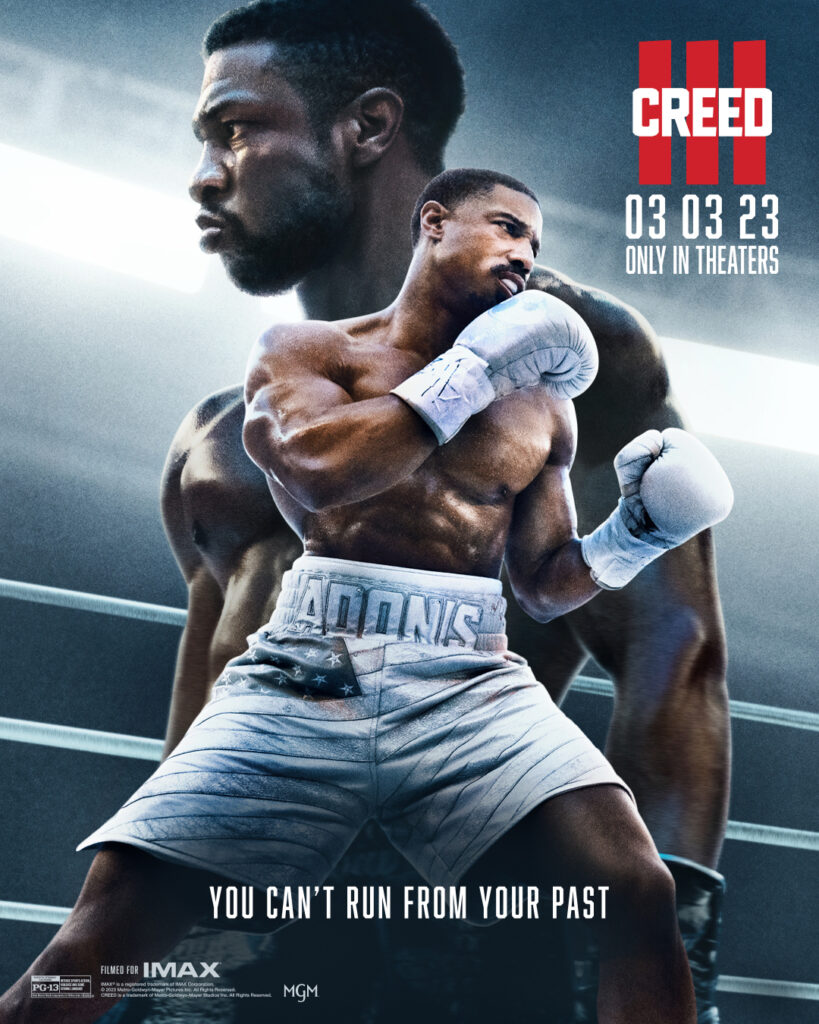
Picking up some years after “Creed II”, we find Adonis Creed has retired from boxing, focusing his attention on business ventures, among others, owning his dad’s Delphi gym, gaining endorsements from high end companies, promoting and training hand-picked boxers for his own stable, and living a more than comfortable life as a doting daddy to his little girl Amara, husband to wife and now successful music producer Bianca, and being a devoted son to his mom Mary-Anne, the widow of the legendary Apollo Creed and who herself has been in ill health following a stroke.

As to be expected, and as we saw with Adonis’ mentor, Rocky Balboa, things have a way of disrupting “the good life.” In Adonis’ case, it’s the return of a childhood friend, Diamond Damian Anderson who is fresh out of an 18-year stint enjoying the hospitality of the California penal system. And while Adonis is more than willing to lend a hand to his old friend, his idea of lending a helping hand and Damian’s are at opposite ends of the spectrum. In short, Damian wants Adonis’ life; the money, the fame, and the World Heavyweight title. He’s got a chip on his shoulder and a sense of “you owe me” entitlement bigger than some of Adonis’ multi-million dollar endorsement deals, and he aims to collect. Of course, Damian’s presence comes with the requisite gravitas that affects all of those in Adonis’ life.

In addition to returning in the title role as Adonis Creed, Michael B. Jordan steps behind the camera and working with a script by Keenan Coogler and Zach Baylin based on a story by Ryan Coogler, makes his directorial debut helming this third entry in the “Creed” franchise.
As a director, Jordan demonstrates that he has a command of basic visuals and making things “look pretty” which shows smart reliance on his cinematographer Kramer Morgenthau, but he then falls short in many other aspects.
Lighting is particularly effective and beautiful, serving the story well in terms of visual tonal bandwidth and tonal shifts – of which there are many. As a cinematographer, Morgenthau is also well familiar with not only the world of CREED having lensed “Creed II”, but also with darker heavier themes such as those within “Thor: The Dark World”, “Rebel in the Rye”, and “Game of Thrones” series. For example, as we feel the “sun setting” on Mary-Anne Creed with heavier shadows when she visits Adonis and Bianca or during a powerful one-on-one kitchen scene with Adonis or a third act moment which might call for tissues thanks totally to Phylicia Rashad’s powerful performance, lighting is a powerful storytelling tool. Lighting throughout the film is metaphoric as if a shroud or blanket hiding the past and the truth. Morgenthau knows how to use lighting as emotion. Flashbacks are differentiated from the present in visual tone, thanks in particular to some excellent dutching and hand-held camera work.
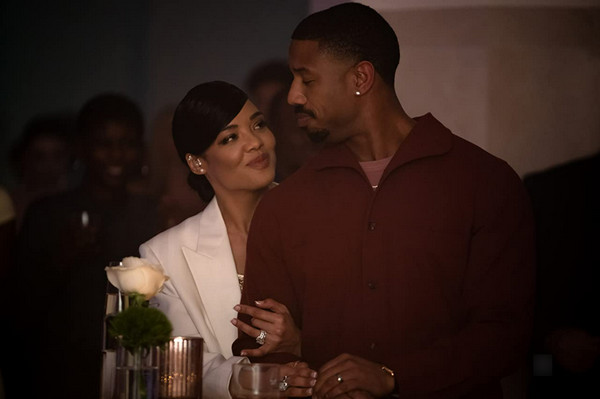
Working in complete synergy with Morgenthaus’ lighting and lensing, notably within Adonis’ multi-leveled palatial and modern home overlooking the city of Los Angeles, is the work of production designer Jahmin Assa. A house filled with shadows and soft warm light complement the metaphoric multiple levels and twisting sharp-edged staircases complete with glass flooring that speaks to the idea of “seeing the truth” of what is unfolding with Adonis and his life. The irony is that the one person who “sees the truth” at all times is little Amara Creed. Compound Assa’s work within the Creed residence with the familial warmth and color of Mary-Anne Creed’s kitchen that speaks to a life fully lived, and the contrast of the Delphi gym, and Jahmin Assa should be on everyone’s radar for future design work.
However, as excellent as the production design is, as cinematic and telling as the lighting is, and as nicely framed as most of the shots are, there is an excessive number of ECUs, and a problem within the overall staging and framing relative to coverage shots. Jordan and his editing team go overboard with cut-away coverage/reaction shots during key one-on-one conversational moments and monologues when he should be setting up and holding on a two-shot that includes both characters. Some monologues that are clearly written to land a punch, instead fall flat because of the rapid back-and-forth cutting between the two characters. It doesn’t allow the audience to emotionally connect with anyone or be impacted by some truly deep conversations. There is no uninterrupted flow. This makes the first half of the film in particular feel like it’s dragging.
Same thing happens with the climactic third act Adonis vs Damian fight. It is chopped to hell in the editing. Never do you feel 12 rounds of fighting from a visual or emotional POV. That fight feels like a blip and not the life-altering, toll-taking a 12-round fight elicits. And that is the biggest problem with the film – we don’t connect with the two main characters.

Having said that, while unimpressed with the actual fight choreography of the Adonis-Damian fight, an “inside the head/dream sequence” during the climactic fight is brilliantly conceived and executed. Stallone spoiled us with the “Rocky” films and the fight choreography with eye-level wide to mid shots that put us in the ring. But we don’t see that here. Even this incredible inside-the-head sequence, while stunning, uses too many zoom ECUs into the eyes that are jarring and disconnecting. While I have no doubt that Jordan saw this as “getting inside the mind of Adonis and Damian”, it fails.

What made the “Rocky” franchise so good and so popular – and by extension, the start of the Creed franchise – is that the “everyman” or the “down and out man” or the average moviegoer connected with Rocky Balboa. He was humble. He never felt entitled. He was always trying. From the first minute we met Adonis Creed in “Creed”, he was written with a sense of entitlement and with a huge chip on his shoulder; there was no heart. The heart in “Creed” and “Creed II” came from an aging Rocky. It didn’t come from Adonis. And while the Coogler and Baylin script here draws upon some key touchstones from the “Rocky” films (most notably Rocky 3, 4, and “Rocky Balboa”) as well as building on training sequencing from “Creed II”, we still never connect with Adonis but for genuine moments he shares with his little girl Amara. You despise Diamond Damian Anderson the minute he appears on screen; he is more despicable than Clubber Lang ever was! A late-occurring plot twist makes you hate Anderson even more. (Quite honestly, a battle between Jordan’s “Killmonger” in “Black Panther” and Majors’ Anderson in CREED III would be a battle worth seeing.). Yet, you still cannot get behind Adonis as he is too flat. We aren’t feeling his inner conflict or the stakes at play. That flatness falls in part on the script but mainly on Jordan’s performance which has not really grown over the three films. But for an expected third-act comeuppance, there is still the sense of entitlement in Adonis that we have seen over the past two films. Joyfully, however, with yet another nod to the complete Rocky-Creed franchise, redemption and purging the past and all that “stuff churning in the gut” does eventually appear like a breath of fresh air.
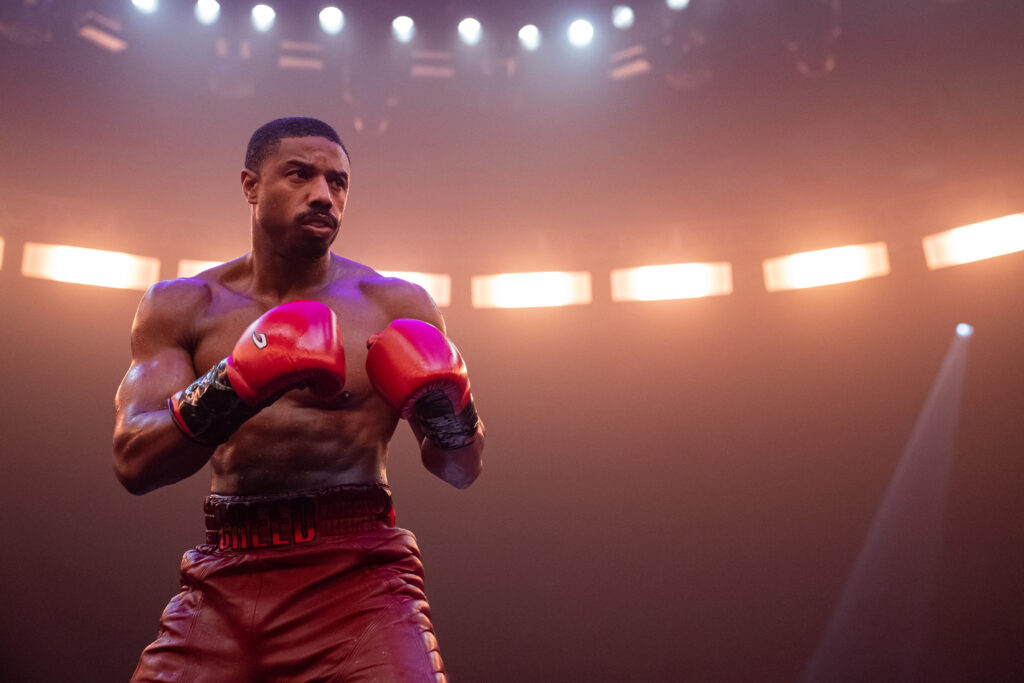
The sound mix is problematic as quite a bit of dialogue is missed because the rap music is so loud. Perhaps it was the screening room in which I watched the film, but I doubt it given the perfectionist nature of the screening room owner. The needledrops themselves sound as if they are modulated much higher than the dialogue or the underlying score. Quite possibly this could be intentional because of Bianca’s and Amara’s deafness and the desire to strike a metaphoric connection with them, but don’t hide the dialogue. That’s what happens in several instances and is quite disconcerting and disconnecting.
The scene-stealer of CREED III, though, is Mila Davis-Kent. As Amara Creed, you just melt every time she’s on screen. Every daddy-daughter moviegoing combo out there will be going “awwwww” whenever she is on-screen or whenever Adonis and Amara are together. Her wanting to learn how to fight and sneaking videos of her dad’s fights is just too cute for words. Amara is a fashionista and a fighter.
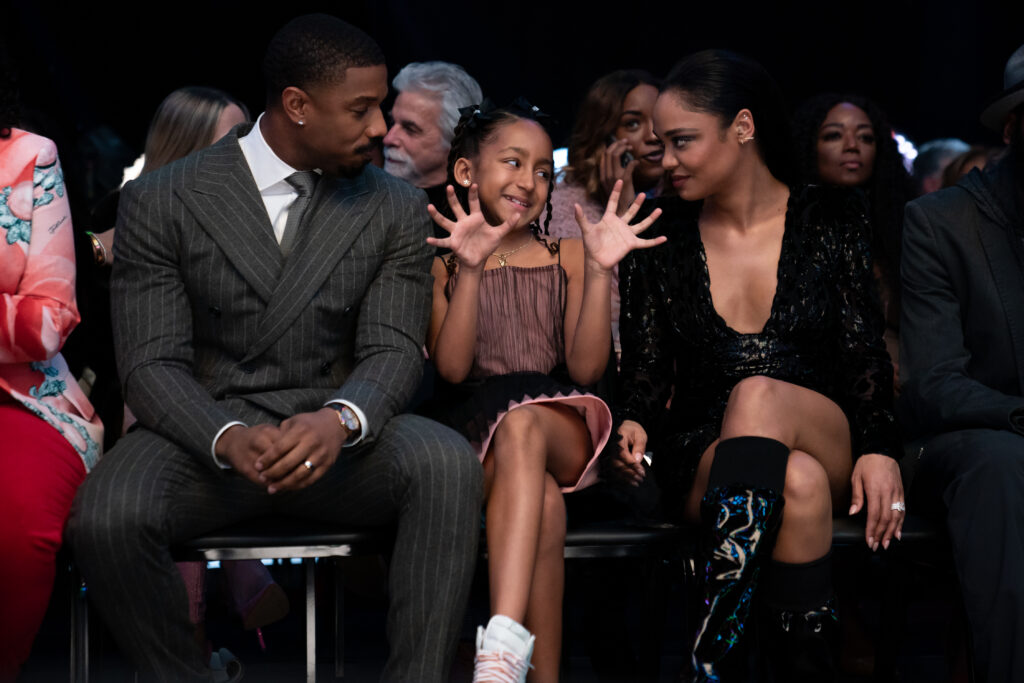
No surprise here as Tessa Thompson is rock solid as Bianca Creed, although Thompson deserved and Bianca needed at least one more good monologue. In addition to Davis-Kent and Thompson, Phylicia Rashad is a big reason to see this film. She will break your heart as Mary-Anne comes to grips with her health issues, long-buried secrets, and a love for Apollo Creed that never faltered. Get the tissues ready.
Wonderful to see Wood Harris back as “Little Duke” Burton with the character carrying on the boxing tradition that was “Duke” as played by the legendary Tony Burton. Also good to have Tony Bellew back as Ricky Conlan. And what would a “Creed” or “Rocky” film be without Jacob “Stitch” Duran. The Creed corner is excellence personified.
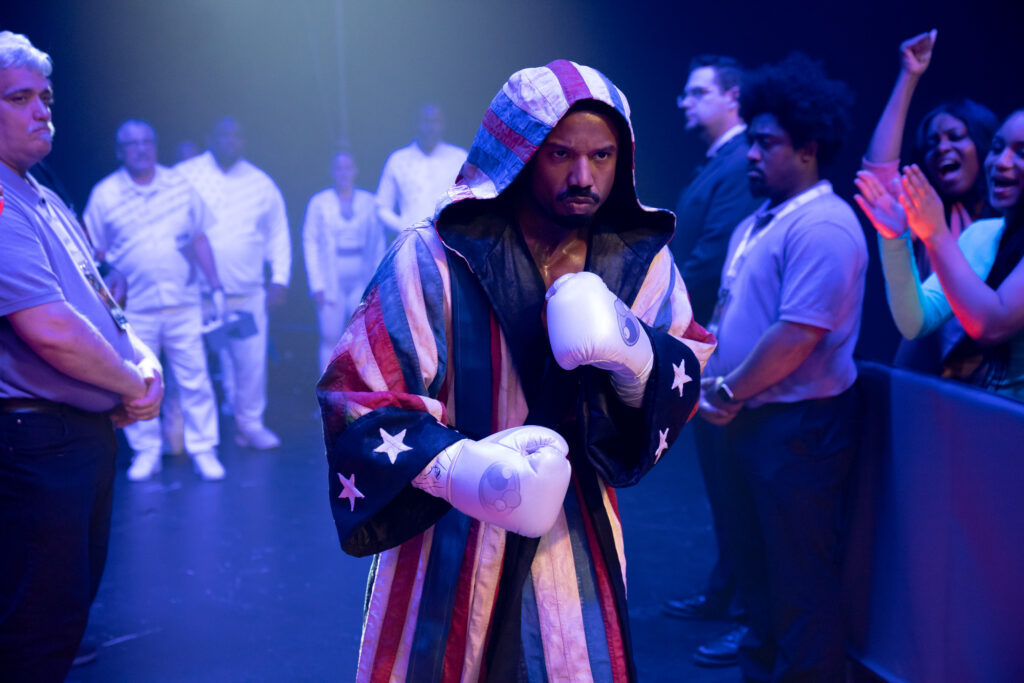
The generational aspect of the franchise holds strong as beyond the Creed legacy, the “Duke” legacy, and yes, even the Drago legacy as Viktor Drago shows up and is again played by Florian Munteanu, we now get a mother-son dynamic with Felix and Laura Chavez played by Jose Benavidez and Selenis Leyva, respectively, as a mother pushing her son to fight, but to fight for the money. Sadly, these are two more characters that don’t have emotional resonance or appeal but Laura Chavez more than proves her mettle as a pushy “showbiz” or boxing mom.
Disappointing is that there’s only one scene with the already legendary Stephen A. Smith who plays himself. Smith always brings something terrific to the table be it as an actor on “General Hospital” or with his own podcast or sports shows.
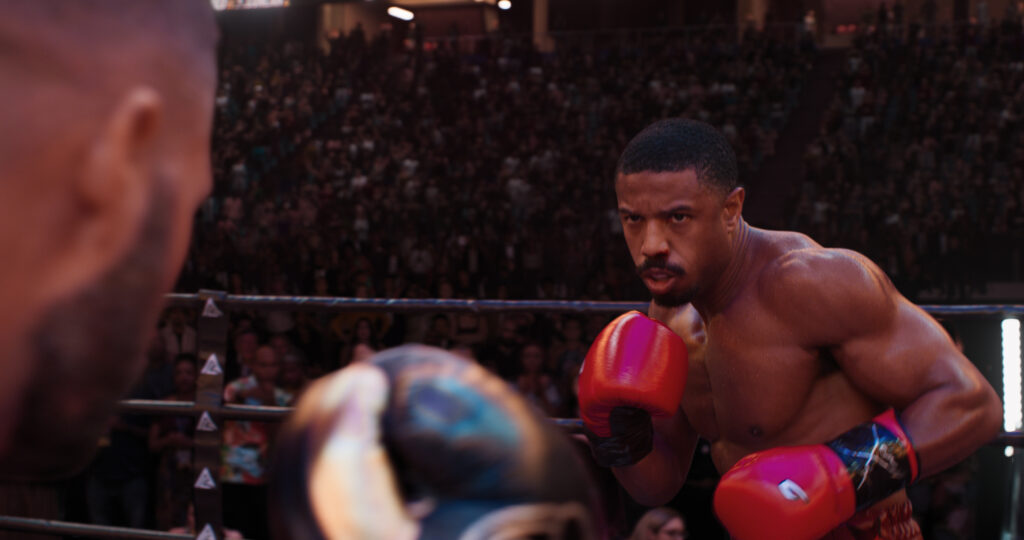
But at the end of the day, it comes down to Michael B. Jordan and Jonathan Majors. Both give fine performances, particularly Majors who is so vile and rage-filled as to be frightening every time he’s on screen. But again, there is nothing warm, resonant, or compassionate and Michael B. Jordan just doesn’t give Adonis Creed the kind of heart and growth the character and the story need.
Ring the bell for costume designer Lizz Wolf as her work is fabulous. While I believe that Jordan wears Armani, the designs for Tessa Thompson and Davis-Kent are fabulous. Be on the lookout for a fun little nod to the costuming of both Sylvia Meals and Talia Shire in the “Rocky” films as both women were wearing blouses/dresses with loose bow ties at the neckline when their husbands were going into a do-or-die fight. Wolf now gives us a nice throwback to those moments dressing Thompson in a stunning blue pantsuit with the big blue bow at the neck.
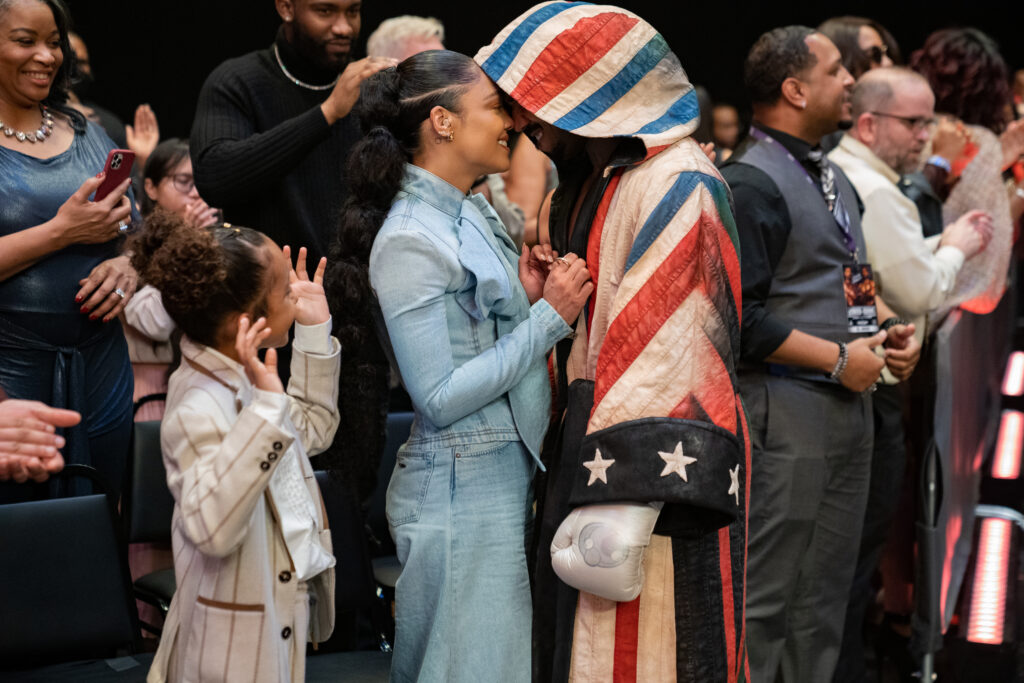
Score by Joseph Shirley does a nice job of providing an undercurrent connecting many of the needledrops into something cogent, but I’m not going to deny it, it’s pure exuberance when we hear a motif or two of some of Bill Conti’s famed “Rocky” scores.
While Michael B. Jordan has said he plans to continue the “Creed” franchise (and hopefully he will), given how CREED III ends, the story is poised to continue in a new direction in a few years. But before Jordan thinks about getting back into the director’s chair and stepping into the ring again, he needs to hone his cinematic storytelling and how to use all the tools in the toolbox to bring a solid story with emotionally resonant characters on the page to life and translate that emotion to the screen. CREED III is a good first directorial effort by Michael B. Jordan, and definitely worth a shot with viewing, but it doesn’t go the distance.
Directed by Michael B. Jordan
Written by Keenan Coogler and Zach Baylin
Cast: Michael B. Jordan, Jonathan Majors, Tessa Thompson, Phylicia Rashad, Mila Davis-Kent, Wood Harris, Jacob “Stitch” Duran, Tony Bellew, Florian Munteanu
by debbie elias, 02/22/2023












